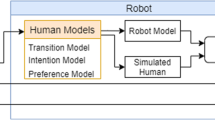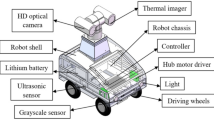Abstract
In order for robots to exist together with humans, safety for humans has to be ensured. On the other hand, safety might decrease working efficiency of robots. Namely, this is a trade-off problem between the human safety and robot efficiency in a field of human-robot interaction. For this problem, we propose a novel motion planning technique of multiple mobile robots. Two artificial potentials are presented for generating repulsive force. A behavior potential is provided for humans. A congestion potential is provided for robots. Through simulation experiments, the effectiveness of the behavior and congestion potentials used in the motion planning technique for the human safety and robot efficiency is discussed. Moreover, a sensing system for humans in a real environment is developed. Finally, the significance of the potential generated from the actual human behavior is discussed.
Access this chapter
Tax calculation will be finalised at checkout
Purchases are for personal use only
Similar content being viewed by others

References
Yamada, Y.: Safety robot technology in the future. Adv. Robot. 23(11), 1513–1516 (2009)
Khatib, O.: Real-time obstacle avoidance for manipulators and mobile robots. Int. J. Robot. Res. 5(1), 90–98 (1986)
Kim, D.H., Shin, S.: New repulsive potential functions with angle distributions for local path planning. Adv. Robot. 20(1), 25–47 (2006)
Ge, S.S., Cui, Y.J.: Dynamic motion planning for mobile robots using potential field method. Auton. Robots 13(3), 207–222 (2002)
Huang, L.: Velocity planning for a mobile robot to track a moving target—a potential field approach. Robot. Auton. Syst. 57(1), 55–63 (2009)
Hoshino, S., Seki, H.: Multi-robot coordination for jams in congested systems. Robot. Auton. Syst. 61(8), 808–820 (2013)
Maniccam, S.: Adaptive decentralized congestion avoidance in two-dimensional traffic. Physica A 363(2), 512–526 (2006)
Burstedde, C., et al.: Simulation of pedestrian dynamics using a two-dimensional cellular automaton. Physica A: Stat. Mech. Appl. 295(3–4), 507–525 (2001)
Pimenta, L.C.A., et al.: Control of swarms based on hydrodynamic models. In: IEEE International Conference on Robotics and Automation, pp. 1948–1953 (2008)
Okada, M., et al.: Human Swarm modeling in exhibition space and space design. In: IEEE/RSJ International Conference on Intelligent Robots and Systems, pp. 25–30 (2011)
Reif, J.H., Wang, H.: Social potential fields: a distributed behavioral control for autonomous robots. Robot. Auton. Syst. 27(3), 171–194 (1999)
Author information
Authors and Affiliations
Corresponding author
Editor information
Editors and Affiliations
Rights and permissions
Copyright information
© 2016 Springer Japan
About this paper
Cite this paper
Hoshino, S., Maki, K. (2016). Motion Planning of Multiple Mobile Robots Based on Artificial Potential for Human Behavior and Robot Congestion. In: Chong, NY., Cho, YJ. (eds) Distributed Autonomous Robotic Systems. Springer Tracts in Advanced Robotics, vol 112 . Springer, Tokyo. https://doi.org/10.1007/978-4-431-55879-8_22
Download citation
DOI: https://doi.org/10.1007/978-4-431-55879-8_22
Published:
Publisher Name: Springer, Tokyo
Print ISBN: 978-4-431-55877-4
Online ISBN: 978-4-431-55879-8
eBook Packages: EngineeringEngineering (R0)



